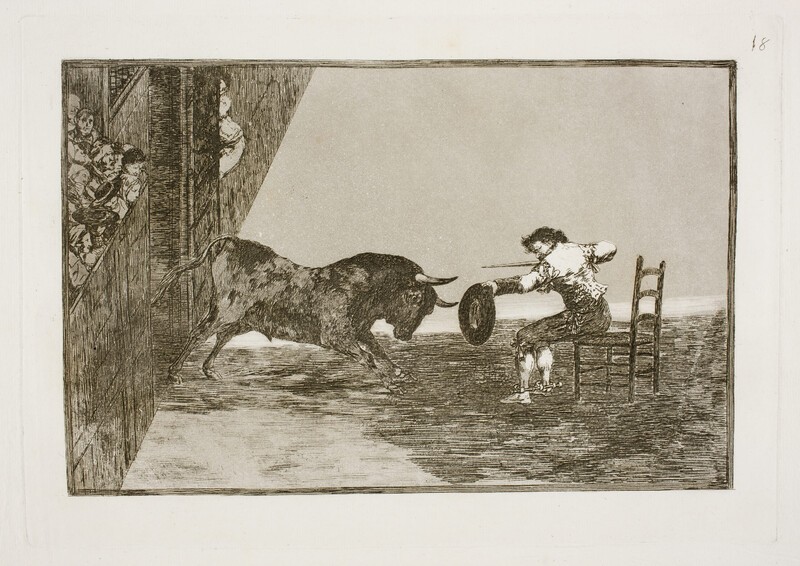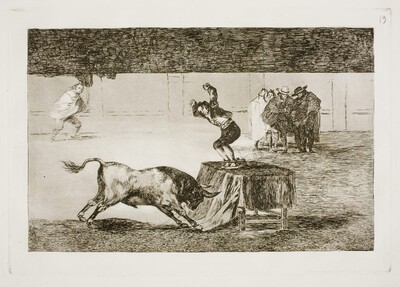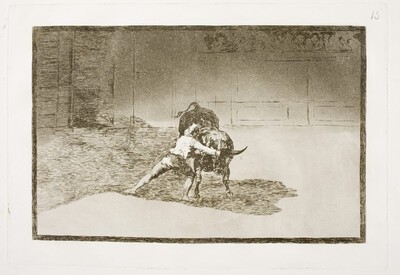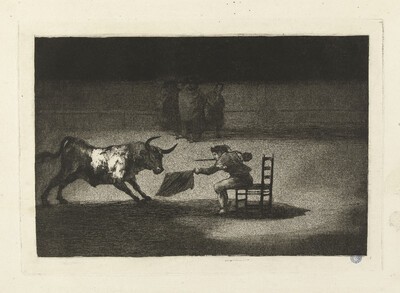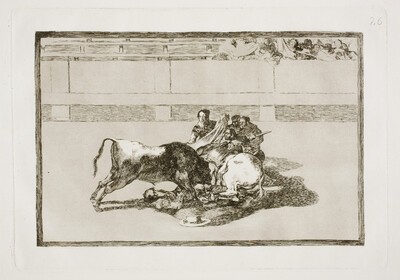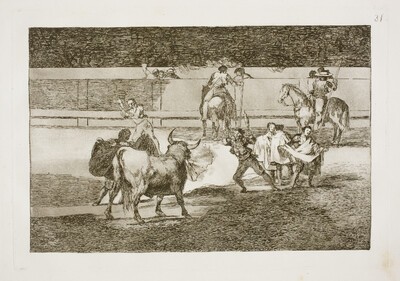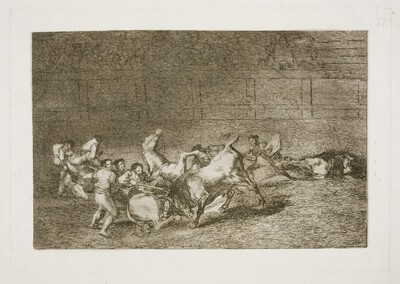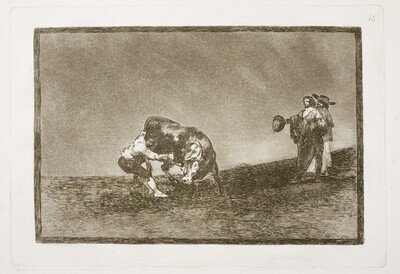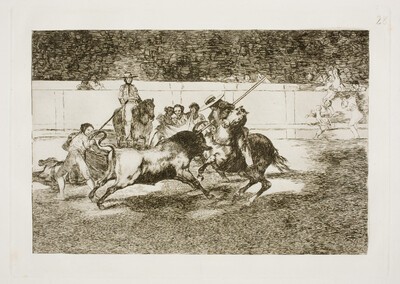- Cronología
- 1814 - 1816
- Dimensiones
- 246 x 354 mm
- Técnica y soporte
- Aguafuerte, aguatinta, punta seca y bruñidor
- Reconocimiento de la autoría de Goya
- Documented work
- Ficha: realización/revisión
- 01 Oct 2021 / 22 Jun 2023
- Inventario
- -
- Otros títulos:
-
See How the ancient Spaniards hunted bulls on horseback in the countryside.
The plate is kept at the National Chalcography (nº 351).
See How the ancient Spaniards hunted bulls on horseback in the countryside.
Third of the five prints of the "extended" version of Bullfighting, dedicated to the exploits of Martincho (Nos. 15, 16, 18, 19 and H). This one focuses specifically on the madness carried out by the bullfighter in a bullfight that took place in Zaragoza and which Goya himself may have attended in his youth. Its composition is remarkable, considering that it changes the point of view he was accustomed to throughout the series, as the Aragonese artist creates unexpected angles of vision for each specific situation and for each of the three characters (bull, bullfighter and spectators) in this engraving.In this case, the bullring barrier can be seen on the left-hand side of the scene, while on the right is the bullfighter seated on a chair with shackles on his feet, ready to kill the bull, who has just come out of the bullring door. The bull, who has seen Martincho, makes the gesture of charging at the bull in front of him. The bullfighter, seated in the saddle, rapier in one hand and hat in the other, looks defiantly at the beast. The audience behind the barrier is watching the action with rapt attention.
Almost the entire scene is tinged with the grey typical of burnished aquatint, except for the bullfighter's jacket, the only point of light in the scene. The darkness of the bull and the shadows on the ground around the figures are particularly striking, although the shadow in the upper left-hand corner is particularly striking, allowing us to focus our attention on the central area of the composition.
The first manuscript title that Goya gave to the print, Killing Seated, with Shackles, typically Goyaesque in its brevity and conciseness, is very precise in relation to the action that Martincho performs: killing the bull while seated and with his feet locked in shackles.
According to Glendinning, the somewhat distorted way in which the faces are treated, which in his opinion implies a criticism of those who participate in one way or another in a bullfight, relates this picture to other Bullfighting pictures such as AAnother Madness of His in the Same Square, Ceballos himself, mounted on another bull, broke rejones in the bullring of Madrid, A bullfighter falls from his horse under the bull, The hard-working Rendón stinging a bull from whose fate he died in the bullring in Madrid, Fire flags, and Two groups of bullfighters run over at once by a single bull.
Sayre, for his part, stresses the bold composition, characterised by the diagonals in the stretcher, and points out that the print is related to the next one, Another Madness of His in the Same Square, by the title.
The print is also closely related to another engraving of similar subject matter that was discarded by Goya but of which three state proofs are known: Fearlessness of Martincho (Bullfighting H).
There is a preparatoryy drawing for this print aldo entitled Martincho's recklessness in Zaragoza square.
18 (print, upper right-hand corner)
-
Grabados y dibujos de Goya en la Biblioteca NacionalBiblioteca NacionalMadrid1946catalogue Elena Páez Ríos
-
Goya en la Biblioteca Nacional. Exposición de grabados y dibujos en el sesquicentenario de su muerteBiblioteca NacionalMadrid1978May - June 1978
-
Grabados de Goya: colección propiedad de la Biblioteca Nacional, que se conserva en su Gabinete deCasa de la Amistad de MoscúMoscow1979exhibition displayed from January 18th to 31st 1979
-
1984
-
Madrid1987
-
Madrid1990
-
Goya grabadorFundación Juan MarchMadrid1994consultant editors Alfonso E. Pérez Sánchez and Julián Gállego, from January 14th to March 20th 1994
-
Goya grabadorMuseo del Grabado Español ContemporáneoMarbella1996from March 8th to May 5th 1996
-
Zaragoza1996
-
Schlaf der Vernunft. Original radierungen von Francisco de GoyaMunich2000
-
Madrid2002
-
Madrid2002
-
Goya en tiempos de guerraMuseo Nacional del PradoMadrid2008consultant editor Manuela B. Mena Marqués, from April 14th to July 13th 2008cat. 151
-
Bilbao2012
-
Goya et la modernitéPinacothèque de ParisParís2013from October 11st 2013 to March 16th 2014cat. 31
-
Goya: Order and disorderMuseum of Fine ArtsBoston2014cat. 98
-
Zaragoza2017
-
1946pp. 177-216, espec. p. 198
-
BarcelonaTartessos-F. Oliver Branchfelt1946 (reed. 1951)
-
1961pp. 120-127
-
OxfordBruno Cassirer1964vol. II, 1964, p. 333, cat. 221
-
Vie et ouvre de Francisco de GoyaParísOffice du livre1970p. 278, cat. 1186
-
The Changing image: Prints by Francisco GoyaBostonMuseum of Fine Arts1974pp. 225-227, cat. 178-179
-
MilwakeeMilwaukee Art Museum1986pp. 18 y 24
-
Goya, toros y torerosMadridMinisterio de Cultura, Comunidad de Madrid1990p. 101, cat. 33
-
MadridCaser-Turner1992pp. 31-32
-
Goya y Aragón. Familia, amistades y encargos artísticoscol. Col. Mariano de Pano y RuataZaragozaCaja de Ahorros de la Inmaculada de Aragón1995p. 225
-
Catálogo de las estampas de Goya en la Biblioteca NacionalMadridMinisterio de Educación y Cultura, Biblioteca Nacional1996cat. 339
-
MadridMuseo Nacional del Prado2001pp. 70-72
-
MadridMuseo Nacional del Prado y Ediciones El Viso2008pp. 426-427, cat. 151
-
ParísPinacoteca de París2013p. 107
-
Goya: Order & DisorderBostonMuseum of Fine Arts Boston Publications2014p. 170
-
Goya. In the Norton Simon MuseumPasadenaNorton Simon Museum2016pp. 186-201
